We watched helplessly as the B-57 labored to raise its flaming
nose again--and suddenly it popped up--and the bomber was airborne but
shuddering dangerously close to stall speed. The pilot 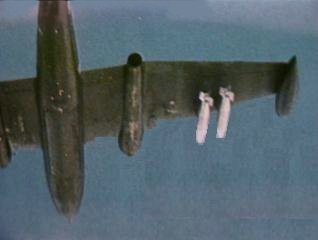 instantly raised its landing gear in an attempt to reduce air drag.
The plane did gain precious air speed and an altitude of at least
fifty feet, its wing overflying a sentry waiting to be relieved.
Without warning, the Canberra wig-wagged its tail and began to
settle back to the earth--less than three-thousand feet to the end
of the runway, perimeter road, concertina wire, and the largest a field of
landmines in South Vietnam. instantly raised its landing gear in an attempt to reduce air drag.
The plane did gain precious air speed and an altitude of at least
fifty feet, its wing overflying a sentry waiting to be relieved.
Without warning, the Canberra wig-wagged its tail and began to
settle back to the earth--less than three-thousand feet to the end
of the runway, perimeter road, concertina wire, and the largest a field of
landmines in South Vietnam.
The B-57's fuselage tail scrapped the surface first, then the
body belly-flopped hard. Landing gears-up,
the fully fueled and armed bomber slid and scrapped along the runway
flaming sparks like a high-speed but upside down car sliding
on its roof. Metal to runway, the scrapping-screeching noise
of a thousand fingernails on blackboards assaulted our ears.
The bomber slid on the pavement from runway's center toward
the right edge. God knows how, it bounced airborne again then
immediately pancaked on the runway shoulder and plowed a shallow
furrow for several hundred feet raising a dust storm and skidding sideways.
Wind quickly swept the dirt-cloud away and we could see the bomber, still upright, as it rocked from left wing and settled
onto the right bomb-laden wing. All was quiet as the cockpit
opened and the pilot, Captain Leon Boyd Smith II, climbed
out near the wing. Miraculously, the crewman Major Elijah
Goar Tollett Jr., followed him, both standing near the dipped
wing no doubt surprised to still be alive! A 500 pound bomb
directly beneath the wing near where they were stood exploded.
The first millisecond: a glass-dome a hundred yards at its
base and filled with white-fire engulfed the bomber. The next
instant: a massive concussion wave (literally visible like
a fog) slapped sentry dogs and handlers to the ground. Debris
rained down from the heavens and a large chuck of fuselage
crashed on the rim of a gouged red-earth crater as a Hiroshima-like mushroom cloud roiled upward--black smoke with raging fireballs within.
The wreckage, strewn over hundreds of yards, began burning furiously.
A hundred-pounder exploded in the bomb bay, hurtling 5,800 pounds of
unexploded bombs like dagger-leafs in a hurricane. 20mm cannon
shells began to cook-off, adding a surreal fourth of July effect,
like fireworks and Roman Candles.
Crash and Rescue trucks began to arrive nearby, having left
their hangers before the wounded bomber had settled to earth
for the last time. Fire fighters leapt from their Pumpers, and seemed to pause
as if resisting orders to climb back onto the rig. The Crash
Crews, as one, jumped back in and on the Rescue Trucks and
raced backwards away from the exploding holocaust before them.
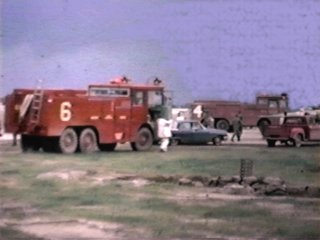
A Pedro Rescue Helicopter orbited directly above the bomb-spewing
cauldron as flaming tongues of fire taunted it closer. Another
bomb exploded and 20mm cannon shells spewed wildly. The chopper,
dangling its globe of fire retardant, suddenly flipped on
its side and fell a hundred feet before righting itself and
riding the heat-thermals away to safe orbit. Oily black smoke
roiled from the flames. For more than an hour, exploding ordnance
rocked Đà Nàng Air Base, as fellow pilots waited for the inevitable
news of death.
Night was falling fast. Another half hour had passed since the last bomb detonated
in a fireball which revealed the carnage had actually formed
its own cloud layer above. The Pedro Rescue chopper returned and
dumped its fire retardant chemicals on the billowing flames.
Like a team of wolves on a fallen prey, Crash Crews attacked
the fallen bird. Hundreds of gallons of fire retardant foam
was sprayed, from roof mounted cannons, on the main wreckage
and nearby glowing bomb casings. Oily smoke was everywhere
and rotating emergency red lights strobed the ground-hugging
smoke adding a surreal effect to the crash.
Rescuers shouted, P.A. systems calmly barked orders, and teams
of highly trained men went about their tasks in silver space
suits. War, once more, had provided a real-live hands-on experience. MMS men began searching for unexploded nearby bombs, and gave orders to secure the area until dawn would permit further search for bombs laying in tall grass over a wide area.
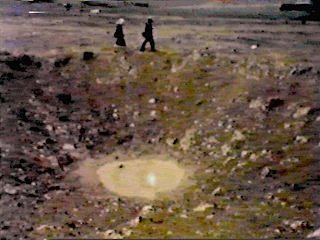
Through the night, a monster bomb crater gaped like a black
eye-socket in its promise to reveal something hideous.
At dawns first light, the foamed wreckage was still too hot
to touch. Wisps of gray-white smoke signaled a warning of
potential danger. The smoldering pit, thirty feet across and
twenty feet deep, oozed a sludge of muddy-foam on one side,
in stark contrast to the red-clay. A two foot deep pool of
water and scum ringed the bottom. The stench of JP-4 jet fuel
and plowed earth was heavy in the air.
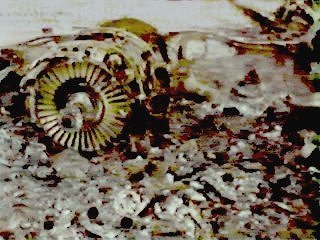
Bomb disposal teams combed the field, carefully removing unexploded
bombs and cannon shells. A Crash Truck was manned nearby with a fire fighter alert
at the water-cannon. A cluster of other Crash Teams parked
a hundred yards further away. Air Police guarded the
crash site as investigators searched the broken earth. At
a signal from a Crash Team leader, a crowd of rescuers gathered
near a stump of something. The leader, dressed in a silver
suit, was covered in dirty foam and smeared with charcoal-soot.
Like others, he had entered the fires of hell at its zenith,
hoping--but knowing --that nothing--no-thing
could live.
Several men stared down at the... remains... and one
called loudly for stretcher bearers. Amongst the smoldering
debris were human remains, including a charred torso stump;
headless and limbless.
The group of K-9 handlers crossed the runway. Night was coming and the runway perimeter area had to be secured. K-9 posts were adjusted well away from the danger of encountering scattered bombs.
It was a long night.
At Đà Nàng Air Base, aerial combat and battle damage certainly took a toll
on pilots and crews. Worn equipment, fatigued pilots and ground
crews--and simple Acts of God took too many others,
who gave so much in return for so little.
B-57 Canberra, 0-33876
B-57 at morning's first-light.
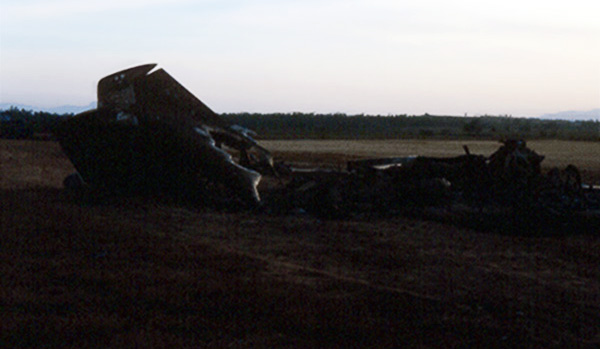
|
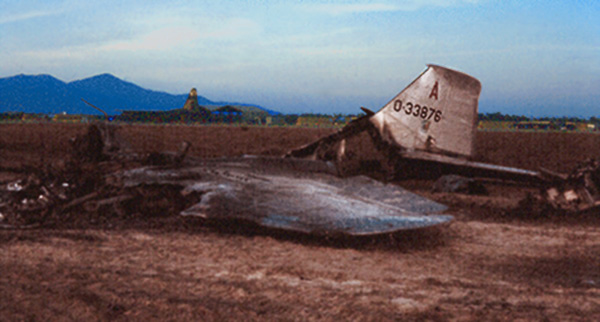
Đà Nàng AB flight line in background, across the runway.
|
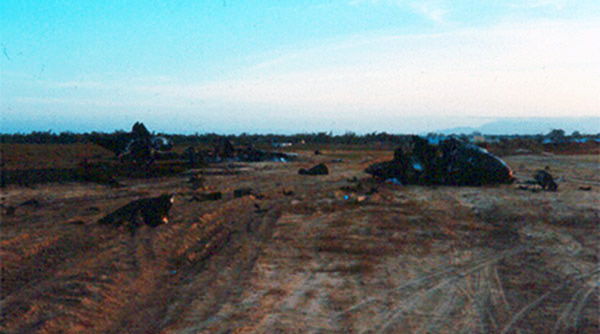
B-57 blown apart and scattered in a thirty-yards
debris field.
|
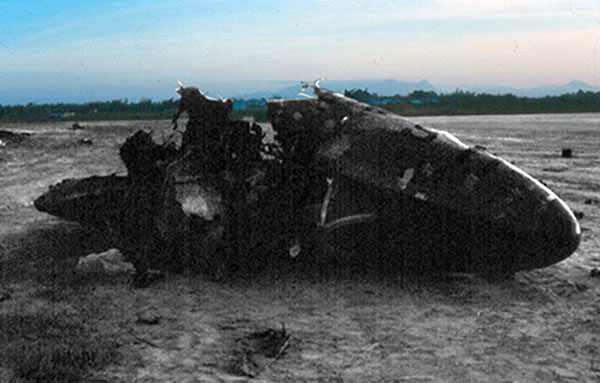
B-57 Nose remains.
|
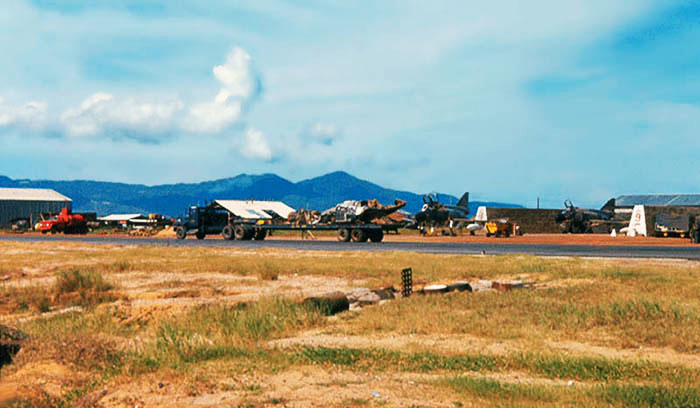
B-57 debris loaded on a flatbed truck en route to a hanger for evaluation, then to its final resting place in an aircraft boneyard.

EMAIL Responses
|
From: Phillip J. Lane
Sent: Monday, April 22, 2002 6:34 PM
To: don@war-stories.com; larry@larryposs.com
Subject: 311th Air Commando Squadron, "Harry Haughton's Hog Haulers"
I was surfing for references to the 311th and came upon a story of a B-57 crash at Danang. The crash story was very interesting since I was there that night and saw it happen. I was a C-123 pilot on alert for flair missions and happened to be standing outside of our alert trailer and watched the crash unfold. I climbed up on the banister of the alert trailer to get a better view, and was awed by the fire and the 20mm cooking off. Then the 500 pounder went off and the resulting shock wave knocked me off of the banister.
The B-57 story awoke some memories... but... my question is how can I access the info about "Harry Haughton' Hog Haulers". I was one of Harry's pilots (Apr 1965-Apr1966) and certainly qualify a "Hog HAULER".
I appreciate your help, and will read more stories.
Phil....
Phillip J. Lane
Major USAF (Retired)
From: Stephen Smith (son)
Sent: Friday, February 28, 2003 12:30 PM
To: don@war-stories.com
Subject: War-Stories: B57-Canberra; KIA: USAF-Capt.Smith, Leon-Boyd; Major-Tollett, Elijah-Jr.
Mr. Poss,
Two years ago, while surfing the Internet, I decided to research the type of aircraft my father flew when he was in Vietnam, to try to
find a picture of one. Being a father myself now, I had recently
taken an interest in trying to learn something of the father that I
had never really known. He had died when I was only five years old.
Whether due to our youth, or an unconscious attempt to keep pain at
bay, all that my two younger brothers and I knew was that he had died
in Vietnam in an aviation "accident", that he was buried in Arlington
Cemetery, and that his name was on The Wall. I had a few vague
memories of him, just a few mental snap-shots. And our family has
kept in touch with an old friend of his.
I was stunned when, a few clicks into my search, I found your web page
recalling so vividly the death of my father, Capt. Leon Boyd Smith II.
I had never known any of the details, but reading your story took me
there, hit me hard with the reality of it and the impact it had on others.
In the two years since, I have often thought of emailing you, but have
never known quite what to write, quite what to feel. I still don't.
I just felt a compelling need to reach out in some kind of
acknowledgment, to share with you that the events of that day in 1966
still echo in many lives.
Stephen Smith
Response: Dear Stephen: The day your father died is as vivid to me, 33 years later, as the day it occurred. Years later, I felt it necessary to write out what had happened, and perhaps touch someone who knew the pilots. There have been many responses over the years. I know exactly how you felt about e-mailing.
I felt the same way when a KIA friend's sister suddenly e-mailed out of the blue, but when I finally was able to contact her I was grateful that she had made that first effort.
I do not think I can add much about that day. Your dad was, and is, a hero who served his country well. Perhaps you know the mission he was engaged in was completed successfully by his fellow pilots. I do have many photos, not posted, of BE-57s at Danang. Perhaps one could be of your father... although that is a long shot. If you want, I will e-mail them to you.
God bless. It seems that your parents did a very good job of raising a fine son. Don Poss
From : Robert F. Baity,
Major, USAF Retired
Subject: B57
Canberra
Don: Reference is made
to the B57 Canberra lost at Đà Nàng in January, 1966. I was
a member of the 13th Tactical Bomb Squadron and was on the
flight line getting ready for a flight scheduled to take off
1 hour and twenty minutes after the aircraft which crashed
on takeoff. My Pilot was Major Charles Rose and I was the
Navigator-Bomberdier. We did complete
the mission
, but I can attest that we made a very
careful pre-flight of our aircraft. Another fact leading up
to this doomed flight was that the Navigator crewed with Capt.
Smith had just that day resigned his flying status. Major
Tollett, who was the Squadron Navigator replaced Captain Smith's
Navigator on that flight. I cannot remember Captain Smith's
former Navigator's name but he was a First Lieutenant.
Sincerely,
Robert F. Baity,
Major, USAF Retired
From : Howard D. Tollett
(Flush), Cousin of Major Tollet
Subject: B57
Canberra
Don: I never
knew how my cousin died
, until I read your B-57
Canberra fighter-bomber story of what happened. Before, I
only saw his name on The Wall, but didn't know. I was in the
Air Force in the early 70's, was in the 4MMS, and being a
distant cousin to Maj. Tollett. This was something of interest
to me. I saw his name on the Traveling model of The Wall;
last year, but all they had was his age, and no information
on the crash.
Did you see it Don? It would be bad to
live through the crash thinking, We made it, then having
the bomb go off. I thought the bomb had to fall a distance,
before it would arm itself? I'd have to find out more about
my old job. If you run across some old MMS guys, have them
hash this out with me. Thank you. Howard
D Tollett
Response: Howard,
yes, I witnessed your cousin's death. I have tried to faithfully
recreate that event in the writing, research, and dedication
of the story, B-57 Canberra fighter-bomber, to USAF Capt.
Smith, Leon Boyd II and your cousin, Major Tollett, Elijah
Goar Jr. Out of the 94 B-57s that were assigned to the Southeast
Asia theatre, 51 were lost in combat (including 15 destroyed
on the ground). There was indeed a moment of hope when the
B-57 seemed to lift-off in spite of the collapsed nose-gear.
And when it fell to earth and slide across the field near
the end of the runway, another moment of hope as the cockpit
opened and the pilot, Captain Leon Boyd Smith II, climbed
out near the wing and Major Tollett followed him. A 500 pound
bomb, directly beneath the wing near where they stood, exploded
and both men died instantly.
I can put you in touch with another
K-9 handler that was with me waiting to cross the runway until
the B-57 took off, if you are interested in another witness'
viewpoint. Don Poss
From: Don Jones
Subject: I want to comment on https://www.vspa.com/dn-b57-01-1966.htm)
Date: July 21, 2014 a t7:31 PM
To:dp-lm37@vspa.com
At the time of the B-57 crash, referred to by Don Poss, I and several other K-9 Teams were
awaiting clearance from the Base Tower to cross the runway to then fan out to our K -9 posts on
the other side of the runway. As we waited near the runway, we watched the B-57 begin to take
off down the runway. I suddenly saw the front landing gear collapse and sparks fly as the plane
approached our K-9 group. I yelled for everyone to run back toward the aircraft parking apron as we were potentially in the crash zone. As the plane crashed and burned on the other side of the
runway, directly across from us, there were ordnance explosions and many 20mm cannon rounds
cooking off. Without sand bag bunkers for protection, our K-9 group laid flat on the ground to
avoid injury from the exploding aircraft ordnance. Both the pilot and copilot were unable to
escape and were killed as the aircraft exploded. A large bomb creator from one of the exploding
bombs on one of the K-9 posts was later used by K-9 Teams as below ground protection from
future Viet Cong mortar attacks.
Donald A. Jones
(A1C Danang, AB, Nov 1965-Nov 1966.)
From: Rick Hager [mailto:rhager1@verizon.net]
Sent: Thursday, November 12, 2015 5:49 AM
To: dp-lm37@vspa.com
Subject: Comment (https://www.vspa.com/bh-b57-explosion-1965.htm)
Don Poss:
Comment: I was on the flight line that morning in an A1E cockpit. We were checking the guns and reloading for a mission (my AFSC was 462 Weapons and Munitions). The first explosion caused the plane, with wings folded, to jump or lift upward violently. Sitting in the cockpit all I could see was a giant fireball and smoke above the dash. Immediately after the first explosion occurred I remember exiting the cockpit with another airman who was on the wing beside me. We got to the ground and looked around, we observed no person(s) in the direction of the blast. I was one man of a ten man team on that plane, no one was in sight. We were concerned that we were under attack and unarmed so the two of us headed for our quarters to get our rifles. As we ran between two nearby hangers the second, third and fourth bombs went off in rapid succession. Glass from the hanger windows showered on us. I will never forget it!
After we retreated to the barracks, we were ordered to remain there. Many of the 500lb bombs were fitted with time delay anti-withdrawal fuses. Only EOD teams were allowed on the flight line for the next 5 days. We heard 2 teams were lost during that time frame trying to disarm the bombs. On the 5th or 6th day we were sent to the flight line to retrieve ammunition (unspent) and body parts. We found a lot of both. We policed the entire area prior to others being allowed on the flight line.

After researching
the history of the Martin B-57B, I believe the bomber
lost on January 11, 1966 was the Martin B-57B-MA 53-3859-3876
which exploded on takeoff at Đà Nàng. The aircraft was
piloted by Captain Leon Boyd Smith II, and Crewed by
Major Elijah Goar Tollett Jr.
Official
Information
Smith,
Leon Boyd II
CAPT - Air Force - Regular
30 year old Married, Caucasian, Male
Born on 01/02/36
From Miami, Florida
Length of service 6 years.
His tour of duty began on
Casualty was on 01/12/1966
in Quang Nam Province (Đà Nàng), South Vietnam
Non-Hostile, Fixed Wing - Pilot
Air Loss, Crash On Land
Body was recovered
Panel 04E - Line 66
Official Information
Tollett, Elijah Goar Jr
MAJ - Air Force - Reserve
35 year old Married, Caucasian, Male
Born on 08/30/30
From Chattanooga, Tennessee
Length of service 14 years.
His tour of duty began on
Casualty was on 01/12/1966
in Quang Nam Province (Đà Nàng), South Vietnam
Non-Hostile, Fixed Wing - Crew
Air Loss, Crash On Land
Body was recovered
Panel 04E - Line 68
Specification of Martin B-57B
Canberra 52-1493/1544:
Power-plant:
Two Wright J65-W-5 turbojets,
7220 lb.s.t. each.
Performance: Maximum speed 598 mph at 2500
feet, 575 mph at sea level. Cruising speed 476 mph. Stalling
speed 124 mph. Combat ceiling 45,100 feet. Initial climb
rate 6180 feet per minute. Combat radius 948 miles with
5240 pounds of bombs. 2722 miles ferry range.
- Weights: 27,091 pounds empty, 53,721 pounds
gross, 36,689 pounds combat weight.
- Dimensions: Wingspan 64 feet 0 inches, length
65 feet 6 inches, height 14 feet 10 inches, wing area
960 square feet.
- Armament: Four 20-mm M-39 cannon in the
wings, 290 rounds per gun. 5800 pounds of bombs in internal
bomb bay, 2800 pounds underwing.

Check out The
B-57 Canberra Night Intruder, at War - 1964-1972!
Missions, History, Vietnam, Photos and more! By Marquis (Mark)
Witt, Lt. Col. USAF (Retired)!
|
 instantly raised its landing gear in an attempt to reduce air drag.
The plane did gain precious air speed and an altitude of at least
fifty feet, its wing overflying a sentry waiting to be relieved.
Without warning, the Canberra wig-wagged its tail and began to
settle back to the earth--less than three-thousand feet to the end
of the runway, perimeter road, concertina wire, and the largest a field of
landmines in South Vietnam.
instantly raised its landing gear in an attempt to reduce air drag.
The plane did gain precious air speed and an altitude of at least
fifty feet, its wing overflying a sentry waiting to be relieved.
Without warning, the Canberra wig-wagged its tail and began to
settle back to the earth--less than three-thousand feet to the end
of the runway, perimeter road, concertina wire, and the largest a field of
landmines in South Vietnam.







